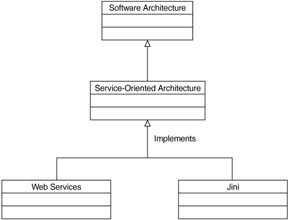Chapter 2: Service-Oriented Architecture
Overview
As we explored in the previous chapter, Web services promote an environment for systems that is loosely coupled and interoperable. Many of the concepts for Web services come from a conceptual architecture called service-oriented architecture (SOA). SOA configures entities (services, registries, contracts, and proxies) to maximize loose coupling and reuse. This chapter describes these entities and their configuration in an abstract way. Although you will probably use Web services to implement your service-oriented architecture, this chapter explains SOA without much mention of a particular implementation technology. This is done so that in subsequent chapters, you can see the areas in which Web services achieve some aspects of a true SOA and other areas in which Web services fall short. Although Web services are a good start toward service-oriented architecture, this chapter will discuss what a fully implemented SOA entails. We will examine the following issues:
-
What is SOA? What are its entities?
-
What are the properties of SOA?
-
How do I design an interface for a service?
Before we analyze the details of SOA, it is important to first explore the concept of software architecture, which consists of the software's coarse-grained structures. Software architecture describes the system's components and the way they interact at a high level.
These components are not necessarily entity beans or distributed objects. They are abstract modules of software deployed as a unit onto a server with other components. The interactions between components are called connectors. The configuration of components and connectors describes the way a system is structured and behaves, as shown in Figure 2.1. Rather than creating a formal definition for software architecture in this chapter, we will adopt this classic definition: "The software architecture of a program or computing system is the structure or structures of the system, which comprise software components, the externally visible properties of those components, and the relationships among them." (Bass, Clements, and Kazman 1997)

Figure 2.1: Software architecture describes a system's components and connectors.
Service-oriented architecture is a special kind of software architecture that has several unique characteristics. It is important for service designers and developers to understand the concepts of SOA, so that they can make the most effective use of Web services in their environment.
SOA is a relatively new term, but the term "service" as it relates to a software service has been around since at least the early 1990s, when it was used in Tuxedo to describe "services" and "service processes" (Herzum 2002). Sun defined SOA more rigorously in the late 1990s to describe Jini, a lightweight environment for dynamically discovering and using services on a network. The technology is used mostly in reference to allowing "network plug and play" for devices. It allows devices such as printers to dynamically connect to and download drivers from the network and register their services as being available.
The goal in developing Jini was to create a dynamically networked environment for devices, services, and applications. In this environment, services and devices could be added to and removed from the network dynamically (Sun Microsystems, Jini Network Technology, www.sun.com/jini). There is more interest lately in the software development community about the concepts behind SOA because of the arrival of Web services.
Figure 2.2 shows that other technologies can be used to implement service-oriented architecture. Web services are simply one set of technologies that can be used to implement it successfully.

Figure 2.2: Web services are one set of technologies for implementing service-oriented architecture.
The most important aspect of service-oriented architecture is that it separates the service's implementation from its interface. In other words, it separates the "what" from the "how." Service consumers view a service simply as an endpoint that supports a particular request format or contract. Service consumers are not concerned with how the service goes about executing their requests; they expect only that it will.
Consumers also expect that their interaction with the service will follow a contract, an agreed-upon interaction between two parties. The way the service executes tasks given to it by service consumers is irrelevant. The service might fulfill the request by executing a servlet, a mainframe application, or a Visual Basic application. The only requirement is that the service send the response back to the consumer in the agreed-upon format.
EAN: 2147483647
Pages: 210